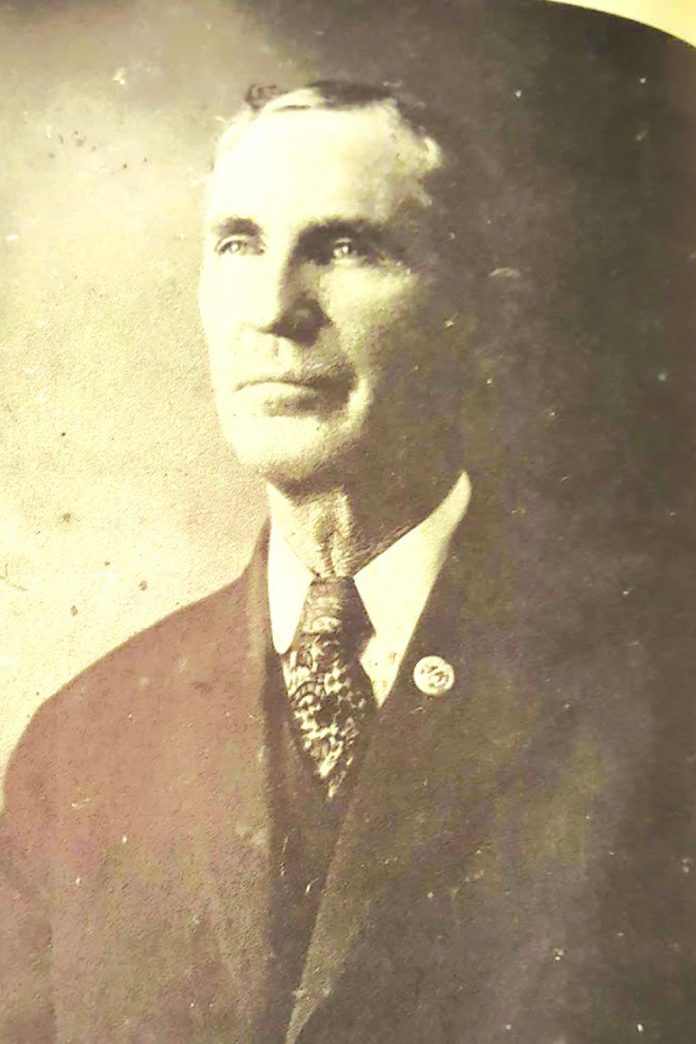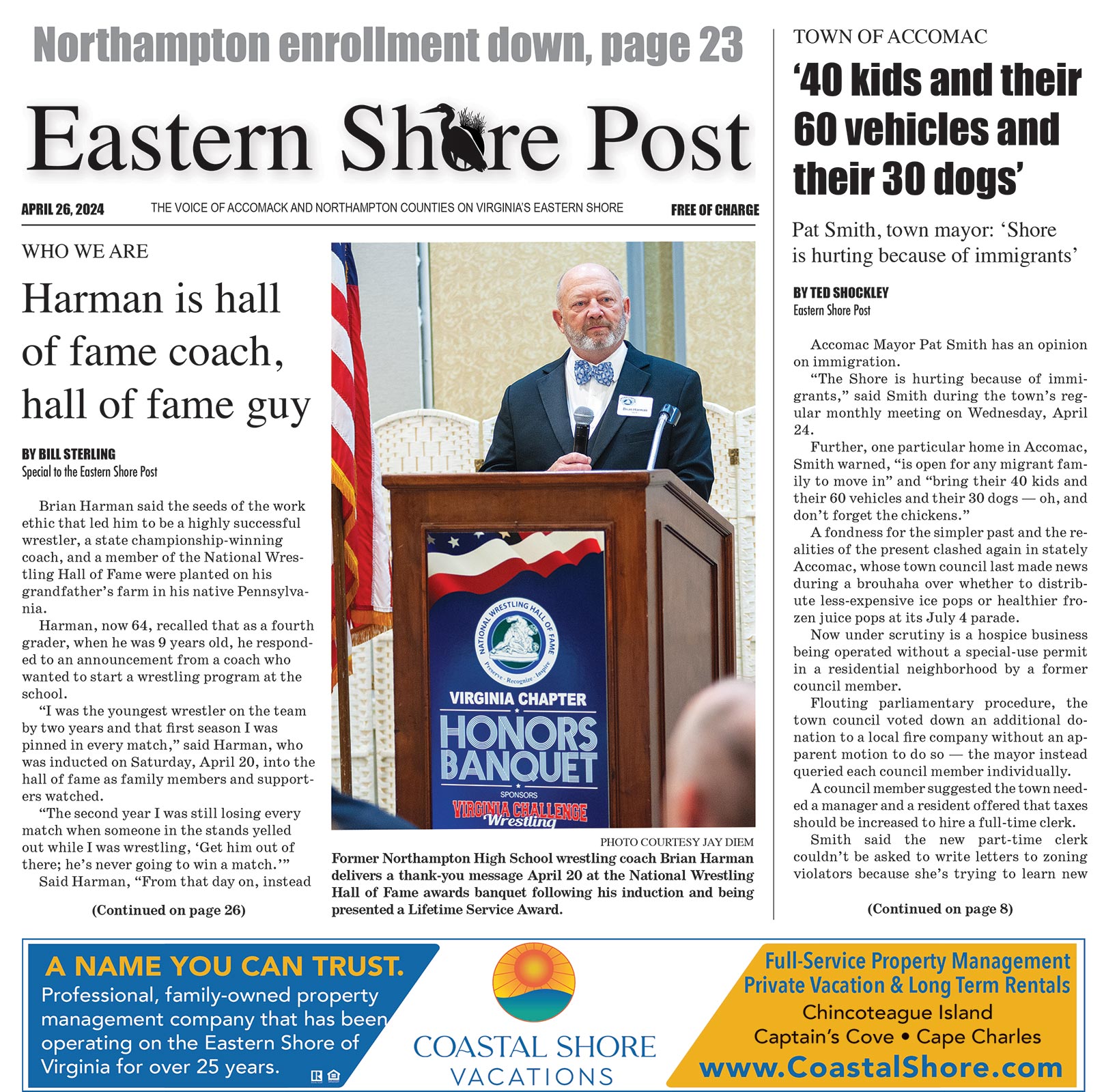By Carol Vaughn —
Capt. Leonard Tawes “was an Eastern Shore gentleman in every sense of the word,” according to Paul Ewell, a maritime historian who is determined to make Tawes’ story more widely known.
Ewell, a professor of management, business, and economics at Virginia Wesleyan University with deep roots on the Shore, has a passion for preserving — and educating people about — the Eastern Shore of Virginia’s rich maritime heritage.
After learning about Tawes in the course of doing research on the Chesapeake Bay pungy (a type of schooner peculiar to the Eastern Shore), Ewell became fascinated by the successful coasting captain’s life.
“I’m obsessed with him,” Ewell said, noting Tawes has been a major focus of his research for over seven years, including taking him and his wife, Sandra, from Florida to Canada to conduct research on the man.
“I probably have 3,000 pages of notes,” Ewell said.
A display Ewell created chronicling Tawes’ story is on exhibit at the Eastern Shore Watermen’s Museum at the Historic Onancock School.
Ewell also is working on a book about the captain.
“It’s not really a rags-to-riches story, but it’s a rags-to-Eastern Shore-riches (story). That’s what I love about it,” he said.
Tawes was born in his mother’s hometown, Craddockville, although his surname is more commonly associated with Crisfield, Md., where his father was from.
His mother, Elizabeth Watson Hyslop, died when Tawes was very young, and his father left him and his brothers largely to fend for themselves, according to Ewell.
Tawes at first worked for a doctor in Pungoteague, then later made his way to Crisfield, where he went to work as a young teen on oyster boats.
At a young age, he ended up on the wharfs in Baltimore.
“He got a job on a ship…He didn’t have a clue…The captain said, ‘We’re going to Rio (de Janeiro)’ and he thought that was near Cape Charles…He had no clue he was going to South America,” Ewell said.
Still, Tawes continued in the maritime life, working his way up from cabin boy to captain, and eventually became part owner of a three-masted schooner, The City of Baltimore, “which was his pride and joy,” Ewell said.
He sailed the schooner for more than two decades along the coast, mainly in trade to the West Indies and South America, according to Tawes’ obituary in the Crisfield Times.
After retiring from the seafaring life in his mid-50s, Tawes ran a successful oyster business in Crisfield and was a respected community leader, including serving as deacon at his church and on the board of directors of the local bank.
The reason Ewell is able to know so much about Tawes is that the captain later in life decided to write down the sea stories he enjoyed telling his family, so that his young niece would be able to know about them after he died.
Every night, Tawes would go out to the summer kitchen at his Crisfield home, or sometimes to his oyster watch house, and write.
Before he died at age 79 in 1932, Tawes over the course of five years wrote 900 handwritten pages detailing his life at sea.
“He chronicled almost every trip he made from when he was a little kid…until he retired,” Ewell said.
In 1967, Tawes’ niece and granddaughter found the manuscript and took it to Robert Burgess, curator at the Mariners’ Museum in Newport News.
Burgess was amazed at what he read.
“Long story short, it is the most comprehensive log, if you will, of an American coasting captain’s life in existence. Nothing like it has ever been written,” Ewell said.
The Mariners’ Museum in 1967 published Tawes’ writings as a book, “Coasting Captain: Journals of Captain Leonard S. Tawes.”
It was while researching a pungy that happened to be the first oyster boat Tawes worked on that Ewell encountered the book.
“I come across this opening sentence… ‘Born in Accomack County, VIrginia, October 2, 1853.’ … If it’s Eastern Shore and it’s maritime, that’s gold. … I was captivated from the get-go,” Ewell said.
His goal became to find out everything he could about Tawes — and to tell his story.
In addition to the fact that Tawes rose from having virtually nothing to become a respected navigator and a successful businessman, “he was one of the most honest, God-fearing, good people I think I’ve ever studied in my life…at a time when ship captains were not known for being nice,” Ewell said.
There is something about Tawes that captivates not only Ewell, but also those he tells about the sea captain.
Ewell is a member of the Mariners’ Museum speakers bureau and gives frequent talks about maritime history to groups.
“Of all the ones I do — and I do them on clippers and schooners and the Eastern Shore and being a waterman…the evolution of boats throughout the history of the Chesapeake Bay — their favorite one is always Leonard Tawes,” Ewell said.
The Eastern Shore Watermen’s Museum and Research Center is housed in the Historic Onancock School on 6 College Ave. in Onancock.
The museum typically is open Saturdays from 10 a.m. to 3 p.m. by appointment. Visitors should call 757-650-4285 or 757-665-5771 when they arrive to be let into the building. Masks are required.
The website is http://www.esvawatermen.org/
The museum is on Facebook at https://www.facebook.com/ESVAWatermensMuseum/
Email [email protected]
Telephone 757-665-5771



